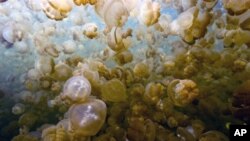By focusing its lens on coral reefs, “The Last Reef 3D: Cities Beneath the Sea,” turns the ocean’s tiniest creatures into movie stars.
The new film explores how this habitat, which shelters nearly a quarter of Earth’s marine life and provides food for billions of people, is under siege from overfishing, urban and industrial pollution and rising ocean temperatures.
The movie captures the drama of daily life from Palau, French Polynesia to the Bahamas and Mexico. Filmmakers Luke Cresswell and Steve McNicholas didn’t just want to make a beautiful film; they also wanted to make a responsible one.
“If you want to protect something you have to first appreciate it,” says Cresswell.
McNicholas adds, “What we wanted to do was show the range and breadth and diversity of life and how all these things interconnect and how losing one element will have a domino effect for that whole ecosystem.”
We take a dip into a marine lake with millions of jellyfish on the Island nation of Palau in the South Pacific. Elsewhere we watch large ocean predators and tiny denizens of the sea like the strangely alien nudibranch and Christmas tree worms.
Shooting the film in 3-D using special macro, or close-up lenses, adds a powerful visual impact on the giant screens found in many science museums.
“The Last Reef” also shows that reefs are in serious decline.
Reefs are suffering “from impacts related to climate change, the warming sea surface temperatures, ocean acidification and land-based sources of pollution and overfishing,” according to John Christensen, director of the Coral Reef Conservation program at the National Oceanic and Atmospheric Administration.
These threats have destroyed 20 percent of the world’s reefs and another 20 percent are likely to decline significantly by 2030, he says. “So not only do we see more dead coral in places that are in serious decline, we see a reduction in biodiversity at large.”
McNicholas and Cresswell hope their film both educates audiences and motivates them to get involved in efforts to save the reefs. A recurring theme is the connection between the cities we live in and those under the sea on which we depend.
Making of "The Last Reef"
“I think that if you’re using time lapses and aerials in a city, it makes you look at the city in a different way," Cresswell says. "You look at the collection of people and you look at the collection of buildings and that helps you look at the reefs.”
These two worlds join in an undersea park in Mexico filled with hundreds of life-sized sculptures cast from real people and objects. The sculptures become the base for a new marine habitat. As children dive in to swim among the art works, the film ends with the message that preserving the coral reefs is “a responsibility we cannot ignore.”










